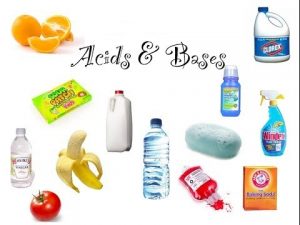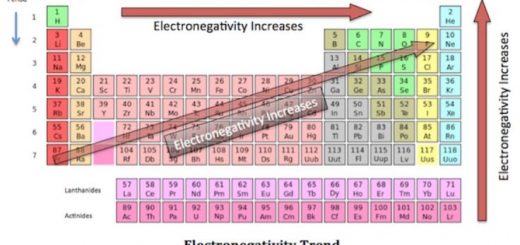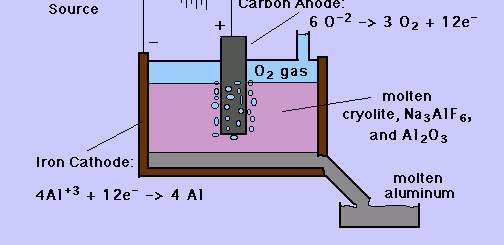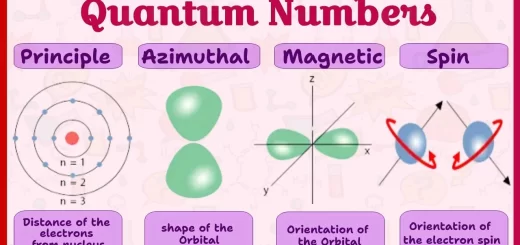Properties of Acids and Bases & Theories defining acids and bases
The acids and bases represent a large part of human life, Acids are used in many chemical industries like Fertilizers, Medicines, Plastic & Car batteries, Bases also have many uses in chemical industries like Soap, Detergents, Dyes & Medicines , For example , The vinegar that is used in some food and cleaning processes is an acidic solution that was early discovered .
Natural and industrial products and the acids and bases entering in their composition or preparation
Acidic plants ( lemon – oranges – tomatoes ) contain Citric acid and Ascorbic acid , Dairy products ( milk – cheese – yoghurt ) contain Lactic acid , Soft drinks contain Carbonic acid and Phosphoric acid .
Soap contains Sodium hydroxide , Baking soda contains Sodium bicarbonate , Washing soda contains Hydrated sodium carbonate .
Properties of Acids
Acids have a sour taste, They change the colour of litmus dye or litmus paper into red, Acids react with bases producing salt and water .
Na OH (aq ) + HNO3 ( l ) → NaNO3 (aq ) + H2 O ( l )
Acids react with active metals producing a salt of the acid and hydrogen gas H2 evolves.
Zn ( s ) + 2 HCL (aq ) → ZnCl2 (aq ) + H2 ( g ) ↑
Acids react with Carbonate or bicarbonate salts causing effervescence and producing carbon dioxide gas CO2 which makes limewater turbid.
Na2 CO3 ( s ) + H2 SO4 ( aq ) → Na2 SO4(aq ) + H2 O ( l ) + CO2 ( g ) ↑
Properties of Bases
Bases have a bitter taste and slippy feel, Bases change the colour of litmus dye or litmus paper into blue, Bases react with acids producing salt and water .
Theories defining acids and bases
The external appearance of the acid and base leads to an experimental definition for each, The experimental definition is based on observation only and doesn’t describe or explain the unseen properties.
The more overall definitions of acid and base come from the studies and experiments that were placed in the form of theories, Acid-base theories are Arrhenius’s theory , Bronsted- Lowry’s theory and Lewis’s theory.
Arrhenius’s theory in 1887
Arrhenius observed that the aqueous solutions of acids and bases conduct the electricity , This observation proves that acids and bases are ionized in the water .
Dissolving of hydrogen chloride in the water : When hydrogen chloride gas dissolves in the water , It is ionized into hydrogen ions ( H+ ) and chloride ions ( Cl−), Dissolving of acid in the water produces hydrogen ions .
Dissolving of sodium hydroxide in the water : When sodium hydroxide dissolves in the water , It is dissociated to sodium ions ( Na+ ) and hydroxide ions ( OH−), Dissolving of the base in the water produces hydroxide ions .
Arrhenius revealed ( proved ) his theory to define acids and bases , Arrhenius acid is the substance that dissolves in the water and ionized or dissociated giving one or more hydrogen ions ( H+ ) .
Arrhenius base is the substance that dissolves in the water and ionized or dissociated giving one or more hydroxide ions ( OH− ) .
According to Arrhenius’s theory we observe that Arrhenius acid must contain a source of hydrogen ions ( H+ ) , Arrhenius base must contain a source of hydroxide ions ( OH− ) .
So, Acids works on increasing the concentration of ( H+ ) ions in the aqueous solutions, Base works on increasing the concentration of ( OH− ) ions in the aqueous solutions .
Explaining neutralization reaction according to Arrhenius’s theory
Neutralization reaction is the reaction between an acid and a base to produce salt and water .
HCl ( aq ) + NaOH ( aq ) → NaCl ( aq ) + H2 O ( l )
The ionic equation of this reaction according to Arrhenius’s theory is :
H+(aq) + Cl−(aq) + Na+ (aq) + OH−( aq ) → Na+ (aq) + Cl−(aq) + H2 O ( l )
Na+ (aq) and Cl−(aq) ions are present in both sides of the equation without changing, So, they can be neglected ( cancelled ) from both sides of the chemical equation , So, the neutralization reaction can be represented by the following equation :
H+(aq) + OH−( aq ) → H2 O ( l )
Observations on ( Deffects of ) Arrhenius’s theory
Carbon dioxide CO2 doesn’t contain a source of ( H+ ) ions, but it dissolves in water giving an aqueous acidic solution .
Ammonia NH3 doesn’t contain a source of ( OH− ) ions, but it dissolves in water giving an aqueous basic solution .
These observations do not agree with Arrhenius’s theory .
The Bronsted- Lowry’s theory in 1923
The Danish Scientist Bronsted and the British one Lowry proposed a new acid-base theory , Bronsted-Lowry acid is the substance that give up the proton ( H+ ) , Proton donor , the Bronsted-Lowry base is the substance that accepts the proton ( H+), Proton acceptor .
Application
Bronsted-Lowry theory describes the behaviour of ammonia as a base .
H2 O ( l ) + NH3 ( g ) → NH+4 (aq) + OH– (aq)
When ammonia gas dissolves in the water , H2 O acts as an acid because it gives up a proton ( H+ ) to ammonia molecule ( NH3 ), As a result of this transfer , OH– formed and it is called Conjugate base , Conjugate base is the substance which is formed when the acid loses a proton ( H+ ) .
NH3 acts as a base because it accepts the proton ( H+ ) from the water molecule , As a result of this transfer , NH+4 formed and it is called Conjugate acid , Conjugate acid is the substance which is formed when the base accepts a proton ( H+ ) .
Lewis’s theory in 1923
Lewis’s proposed an acid-base theory which depends on sharing of a lone pair of electrons between acid and base , Lewis acid is the substance that accepts an electron pair or more, Lewis base is the substance that donates an electron pair or more.
Ammonia is considered as a base , although it does not contain hydroxide group in its structure , Because according to Bronsted – Lowry’s theory , Ammonia accepts a proton from another substance ( as water ) during the reaction and according to Lewis’s theory it donates a lone pair of electrons to another substance ( as water ) during the reaction .
Types of compounds, Properties of Acids, Bases (alkalis), Oxides and Salts
Classification of Acids according to its strength (degree of ionization), Its source & Basicity
Classifications of bases according to strength ( degree of ionization ) and molecular structure
Economic importance of some common acids, bases and salts (minerals)




